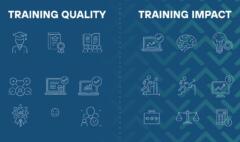Return on Investment (ROI) in Training: How to Measure the Value of Training and Turn It into a Real Gain for the Organization?

Return on Investment (ROI) in Training: How to Measure the Value of Training and Turn It into a Real Gain for the Organization?
Introduction
Why Should We Measure ROI in Training?
In a business environment that is changing and results driven, training is no longer just a complementary activity or institutional luxury. It is now viewed as a real investment that must generate tangible returns in performance and productivity.
But the question that always arises:
- Does the training we provide deserve what we spend on it?
- Did it make a real difference in employee or organizational performance?
- How do I convince senior management that the budget allocated for training achieves real benefit?
Here comes the importance of calculating Return on Investment (ROI), which is the only financial language that convinces management that training is not a “cost” but a “return” that must be supported and developed.
What Is ROI in Training?
Simple definition:
ROI in training is a metric that determines the value of benefits achieved by the organization as a result of training, compared to its financial cost.
Why is it important?
- Helps make smart funding decisions for training programs.
- Shows the true effectiveness of the training program.
- Justifies training budgets to decision-makers.
- Helps compare programs and determine which has better returns.
When do we need it?
- After implementing high cost training programs.
- When evaluating internal academies in organizations.
- In cases of pressure to reduce training budgets.
- While presenting annual reports on training effectiveness.
Difference Between ROI and Other Performance Indicators
| Indicator | What It Measures | When Used | Financial Impact Accuracy |
| Attendance Rate | Commitment and discipline | During training | Low |
| Trainee Satisfaction | Trainee’s impression of the experience | Immediately after training | Medium |
| Skill Improvement | Increase in knowledge or competence | After post course tests | Medium |
| Behavior Change | Extent of application of learned content | After some time post-training | Good |
| ROI | Financial benefit compared to cost | Months after training | Very High |
Conclusion of the discussion: While other KPIs provide internal views of the training experience, ROI focuses on real financial impact, which is what senior management cares about when assessing value.
ROI Calculation Formula in Training
ROI is calculated using the following formula:
Return on Investment (ROI) = (Financial Return from Training − Training Cost / Training Cost) × 100
Practical Example:
- Training cost = 50,000 SAR
- Financial gain after training (performance improvement, error reduction, increased sales) = 80,000 SAR
Apply the formula:
ROI=((80,000- 50,000)/50,000)×100=(30,000/50,000)×100=60%
Result:
This means every 1 SAR spent on training returned 1.6 SAR in benefits, indicating a very positive ROI and reflecting the program’s effectiveness.
Cost Elements Included in ROI Calculation
To calculate ROI accurately, all direct and indirect costs associated with the training program must be identified:
- Direct Costs:
- Trainer or training provider fees
- Venue rental or e-platform cost
- Training materials (printed, electronic, tools)
- Consultancy or software licensing
- Meals, hospitality, transportation (if applicable)
- Indirect Costs:
- Time of participating employees (not working during training)
- Training management costs (coordination, logistics, follow up)
- Impact on workflow during trainees’ absence
- Technical or logistical support
Important note: Some organizations neglect indirect costs, leading to inaccurate ROI calculations.
Every cost related to training must be counted to ensure transparent results.
Methods to Measure Benefits from Training
Calculating the financial gain from training is not limited to increased sales or productivity. Benefits can be multiple direct, indirect, or intangible but impactful:
- Direct Financial Benefits:
- Increased employee productivity (output per time)
- Reduced operating costs (through error prevention or process improvements)
- Increased sales (due to training sales or marketing teams)
- Reduced returns or customer complaints
- Indirect Benefits:
- Lower turnover rates (due to satisfaction with development opportunities)
- Reduced incidents or errors
- Improved product or service quality
- Intangible Benefits:
- Boosted morale
- Enhanced work environment
- Promoted continuous learning culture
Note: For intangible benefits, you can measure impact via non financial indicators, then approximate their monetary value.
Practical Steps to Accurately Calculate ROI in Any Training Center
To achieve precise and realistic results, here is a step by step method to calculate ROI:
- Step 1: Determine Training Cost
Gather all direct and indirect costs. - Step 2: Define Desired Outcomes
For example: reducing task execution time, improving customer satisfaction, increasing sales. - Step 3: Collect Post Training Data
Through tests, observations, performance evaluations, financial data. - Step 4: Calculate Financial Benefits
How much did the company save in time or money after training?
Did production increase? What is its financial value? - Step 5: Apply the ROI Formula
ROI (%) = (Benefits – Costs / Costs) * 100
When Is Training Profitable in ROI Terms?
Any positive value in ROI means the program brought more financial benefit than it cost.
- Positive indicators:
- ROI of 30% or more is excellent for skills programs.
- ROI of 100% (doubling investment) is exceptional.
- When it’s not profitable:
- If ROI is negative, meaning benefits didn’t cover costs.
- If benefits are unmeasurable and not linked to real outcomes.
Numeric Examples of ROI in Real Training Programs
Example 1: Customer Service Training
- Cost: SAR 20,000
- Complaints dropped by 40% after training.
- Each complaint costs SAR 500.
- Complaints decreased by 50 per month × 3 months = SAR 75,000.
- ROI = 100 × (75,000 – 20,000) / 20,000 = 275%
Example 2: In‑house Excel Training
- Cost: SAR 10,000
- Report preparation time improved by 30%.
- Time savings valued at SAR 4,000 per month × 4 months = SAR 16,000.
- ROI = 100 × (16,000 – 10,000) / 10,000 = 60%
Factors Affecting ROI Variation
| Factor | Effect on ROI |
| Training quality | The higher it is, the higher the expected impact |
| Alignment with true need | Increases likelihood of direct impact |
| Management support | Facilitates trainees applying what they learned |
| Training timing | Wrong timing reduces benefits |
| Post‑training follow‑up | Its absence leads to quick loss of impact |
How to Improve ROI in Your Training Programs
- Start with accurate needs analysis.
- Choose qualified trainers with practical experience.
- Link training goals to actual performance indicators.
- Provide interactive, applied training.
- Follow up with trainees after the course.
- Collect real data to assess impact.
Each step executed precisely brings you closer to higher ROI and justifies your training investment realistically.
Difference Between Measuring ROI in Traditional vs E‑Learning Training
- Traditional Training:
- Easier to observe interaction.
- Higher costs (venue, hospitality, travel…).
- Results measurement takes longer.
- E‑Learning:
- Lower costs.
- Requires technical tools to track impact.
- Easy tracking via systems.
In both cases, ROI is calculated using the same methodology provided there is reliable data.
Common Mistakes in Calculating ROI in Training
- Relying only on immediate evaluations.
- Not including all costs.
- Overestimating benefits.
- Failing to track performance post training.
- Ignoring context or other influencing factors.
Avoiding these mistakes gives more accurate results and improves future decisions.
Should You Calculate ROI for Every Training Program? And Why?
Not necessarily for every course, but it’s recommended to:
- Calculate it for strategic or high cost programs.
- Apply it to programs tied to organizational or technical changes.
- Use it in periodic reports to management or partners.
However, having an internal mechanism to estimate ROI generally reflects maturity in training management.
Conclusion
Make Training an Investment, Not a Cost
Measuring ROI in training isn’t just a financial exercise, it’s a mindset shift that turns training from an activity into a strategy.
When you convince management that every Riyal spent returns real value, you are not just managing training… you are building value.
Start measuring ROI today, and rethink how you design, implement, and evaluate every training program…
You’ll see the difference in management satisfaction, results, and sustainability.
Frequently Asked Questions (FAQs)
- What is the acceptable ROI percentage in training?
ROI between 30% and 100% is very good; any positive number indicates investment success. - Can ROI be negative?
Yes If costs outweigh benefits, indicating planning or execution weakness. - What is the difference between ROI and ROE?
- ROI = Return on Investment (financial return).
- ROE = Return on Expectations (achievement of expectations, non financial).
- Should ROI be measured right after each course?
No, it’s best measured 3 to 6 months after training to capture real impact. - How do I convince management of training’s value using ROI?
Present numerical examples, link training to institutional goals, and highlight direct and long term financial impact.



